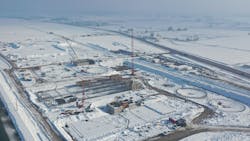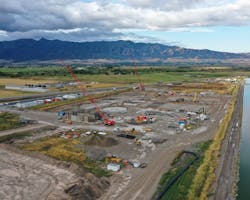Logan Regional Wastewater Treatment Facility | 2023 WWD Top Projects
- Location: Logan, Utah
- Cost: $139 million
- Size: 12,500 GPM
- Owner: Tyler Richards
- Designer: Craig Ashcroft
- Contractor: MWH Constructors Inc.
- Manufacturers: Evoqua, WesTech, Landy7, Fournier, Trojan
Multiple communities in Cache County, Utah, were using an existing 460-acre open-air wastewater lagoon complex to handle their wastewater solids disposal. However, new ammonia phosphorus limits mandated by the State of Utah were much more stringent than previous limits. The lagoons would no longer be able to remove enough nitrogen and phosphorus to comply with U.S. Environmental Protection Agency ( EPA) regulations.
The City of Logan, Utah, took on a project to replace the lagoons with a new 18 million gallon per day (MGD) regional wastewater treatment facility. The project would become the largest magnetite dosing municipal treatment plant in the nation — and the city of Logan’s largest capital improvement project.
The city hired Carollo Engineers as the design engineer under a traditional design-bid-build delivery method. However, with EPA’s tight deadline to meet regulatory requirements, the city needed to select a construction manager and general contractor for an expedited schedule. The city hired MWH Constructors Inc. while Carollo was nearing 90% design completion.
The project’s initial cost estimate exceeded the city’s project budget by almost $64 million. MWH helped to coordinate immediate value engineering workshops at-risk, working with Carollo and the city to reduce the project’s cost without significantly impacting design. Ultimately, the workshops reduced project costs under the city’s budget, and the project finished roughly $1 million under its intended budget.
In addition to cost estimates, the project would face challenges with safety and seasonal changes. The safety concerns came from the harsh weather conditions of Logan, Utah, which could leave snow or mud on-site for six months of the year. MWH and subcontractors implemented safety measures to avoid incidents, including sanding or salting the ground to prevent slips, maintaining clear pathways from the parking lot, and quickly addressing icy conditions.
MWH also implemented a program to identify unsafe conditions, called the “Improve-Its” program. Employees would fill out cards to identify and quickly correct unsafe conditions, defined as “Improve-Its.” MWH had conducted 758 inspections, which resulted in 19,792 Improve-Its. Thanks to these measures and more, the project finished with a strong safety record with zero lost time incidents. The potential risk of cold weather construction also required specific scheduling to ensure safety and quality of work.
Many critical and high-risk activities were planned in the summer, to ensure effective work throughout the year.
“Building in Cache Valley is difficult in the winter,” said Lance Ota, senior project manager for MWH Constructors Inc. “The valley’s geography will trap cold air for days, if not weeks, at a time. Knowing the potential risk of cold weather construction, scheduling was the key to mitigating the safety and quality risks.”
The building of concrete slabs and the bioreactor were planned and completed in summer. The summer work also focused on enclosing buildings and creating spaces for efficient work depending on the season, allowing for continued effective work during inclement weather. The Logan Regional Wastewater Treatment Facility was completed 45 days early and under budget. The plant is now averaging below 0.1 mg/L of ammonia and below 0.2 mg/L of phosphorus.
The old lagoons are no longer needed, and have been emptied, but they continue to help the facility function. Instead of designing the new mechanical plant to hydraulically process peak wet weather flows, influent flows over the design capacity of the plant are diverted to the existing lagoons. This way, the lagoons function as storm surge storage for heavy seasonal runoff, saving the city $40 to 60 million in capital costs.
“Many of the contractors were from the local area and brought a significant pride to being able to participate in the largest single project in the city’s history,” said Ota. “We would encourage one another and supported each other’s efforts enabling win after win. We celebrated successes, milestones and minor victories. The environment was intoxicating and everyone wanted to participate to share in the success.”
Watch the Logan Regional Wastewater Treatment Facility Top Projects video:
About the Author

Jeremy Wolfe
Jeremy Wolfe is a former Editor for Wastewater Digest.


